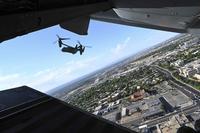"After 10 years and $1.7 billion, this is what the Marines Corps got for its investment in a new amphibious vehicle: A craft that breaks down about an average of once every 4 1/2 hours, leaks and sometimes veers off course. And for that, the contractor, General Dynamics of Falls Church, received $80 million in bonuses," the Washington Post's Renae Merle reports in a brutal front page story.
The amphibious vehicle, which can be launched from a ship and then driven on land, is so unreliable that the Pentagon is ditching plans to begin building the first of more than 1,000 and wants to start over with seven new prototypes, which will take nearly two years to deliver, at a cost of $22 million each.
The Expeditionary Fighting Vehicle is one of the Pentagon's largest weapons programs and exemplifies the agency's struggle to afford a cadre of new mega-systems that are larger and more complex, but also more trouble, than their predecessors.
Despite reforms meant to rein in costs, it is not unusual for weapons programs to go 20 to 50 percent over budget, the Government Accountability Office recently found. Among the offenders is the Army's sprawling modernization program, which aims to update everything from tanks to drones and is now expected to cost $160 billion [or much more -- ed.], up from $90 billion, and a Lockheed Martin missile-warning satellite program, which is projected to cost more than $10 billion, up from $4 billion...
The overruns are eating away at the Pentagon's buying power but not its appetite. The amount the Pentagon plans to spend on major weapons systems has doubled in the past five years, to $1.4 trillion from $700 billion, according to the GAO...
When it was launched in 1996, the Expeditionary Fighting Vehicle was promoted as an example of acquisition reform... But the program has struggled with repeated delays, cost increases, budget cuts and dashed expectations, according to military officials and government reports. Problems range from leaks in hydraulics systems to software glitches, according to the reports. Last year, the vehicles completed just two of 14 planned tests.
"They started out really well, and I was really pleased," said Philip Coyle, the Defense Department's former director of operational test and evaluation. "But gradually the complexity of the program has overcome the contractor, so they are years behind schedule."
General Dynamics defends its progress, noting that the vehicle has met many goals, including being able to reach speeds of 30 knots on the water. The vehicle is fast enough to keep up with the Abrams tank on land, it can carry 17 Marines, and its systems can communicate with other ships and tanks, all key performance criteria, the company says...
An independent review released in December by the Navy's acquisition office questioned the company's commitment to solving the development problems that plagued the vehicle. The report said General Dynamics appeared more interested in starting production than trouble-shooting and didn't manage the groups making many of the decisions. The production phase is typically more profitable for a contractor and often marks a point at which a program becomes more difficult to cancel.
General Dynamics "seems to be focused on production rather than on solving significant design and engineering problems," the Navy report said. "This must be changed if the Program is to move ahead successfully."








